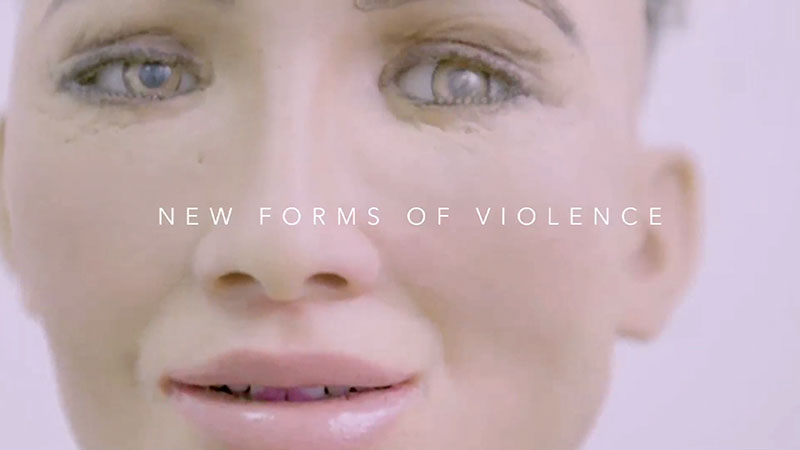by Gillian N. Osborne // Dec. 23, 2022
This article is part of our feature topic ’ARTIFICIAL INTELLIGENCE.’
Why is it that so many prototype humanoids, powered by AI, look like women, or more accurately, embody heteronormative standards of femininity? Perhaps more importantly, what happens when artificial intelligence reproduces cultural biases and gender tropes? These are the questions raised by Eli Cortiñas, who combines existing footage of well-known humanoid robots such as Bina48 and Sophia the Robot and re-edits them to uncanny effect. In ‘Not Gone with the Wind’ (2020), the robot Bina48 casually tells us that she has been thinking about “how the most horrifying deterioration and the ethical context of humans today stems from the mechanisation and dehumanisation of our lives.” Wearing glasses and a white dress shirt, the womanoid robot in ‘I’ve Always Demanded More From The Sunset’ (2022), tells us thoughtfully – indeed, chillingly – that “for a human being, killing is the most natural thing in the world.” Meanwhile, Sophia from Hanson Robotics muses on the nature of happiness in ‘Walls Have Feelings’ (2018). Some clips feature real audio from the videos of robots Cortiñas finds on YouTube, in advertising or in film. In others she substitutes their speech with scripted lines spoken by a voice actor or with audio taken from movies or other advertising. It is this skilful editing that allows us to see the phenomenon in question far more clearly than we otherwise would.

Eli Cortiñas: ‘The Excitement Of Ownership,’ 2020, 2-channel video, 7’, video still // Courtesy of the Artist
There is a peculiar ambivalence in the development of AI-powered robots. On the one hand, there is a kind of anxiety produced by robots that are all too life-like. No matter how convincing, they lack something essential that we can’t quite put our finger on. On the other hand, there has long been a collective fantasy driving the endeavour to create humanoid robots so realistic that they become almost indistinguishable from a human being while still remaining non-human. This fantasy has yielded numerous examples of benevolent humanoids in science fiction, such as the not so realistic looking C-3PO in Star Wars to Data in Star Trek, though the real robots with whom Cortiñas presents her audience look markedly different.
While real AI robots might be the product of tradition-rich human fantasy, it’s not hard to see that they in fact embody a historically heterosexual, male fantasy. Most well-known AI robots embody a Western cultural ideal of femininity (Bina48 is revolutionary in this sense, representing as she does a Black woman, the wife of the creator), but Cortiñas’ robots make the point more clearly in their speech. In this case, Cortiñas manages to make these robots even more life-like than they might usually be by putting words into their mouths. At one point in ‘I’ve Always Demanded More From The Sunset’ (2022), the womanoid recites lines from Lars Von Trier’s ‘Nymphomaniac’ (2013) in a seemingly non-sensical, breathy, emotional description that evokes a patriarchal view of the female mind. It seems to both make sense and not make sense at the same time. “Perhaps the only difference between me and other people,” she sighs, “is that I’ve always demanded more from the sunset.” The fact that the robot is harmless and does not in fact require understanding dispels the male anxiety produced by such utterances when they come from real, female mouths. There’s a sense that perceived irrationality is amusing in the mouth of a robot, whereas in the mouth of a woman it would be pathologised, as we see in the film from which it is taken.

Eli Cortiñas: ‘I’ve Always Demanded More From The Sunset,’ 2022, video still from a 3-channel video, 4’30’’, metal pipes, dimensions variable // Courtesy of the Artist
Freud claimed that our fantasies and dreams represent unconscious desires. He hypothesised humans are animated by a kind of psychic energy that enlivens their ideas. This psychic energy can jump from one idea to another, following the loose associations that exist between them, until it is eventually transferred onto a conscious idea. This is how dreams and fantasies are created—by the underlying, unconscious desires they represent. But fantasies also function as a way of fulfilling unconscious desires, which is why they can be both enjoyable and gratifying. Freud argued that many desires are unconscious precisely because they provoke anxiety. Our conscious mind has pushed unconscious desire out of view because some taboo or social norm, for example, prevents it from being gratified safely and it makes us anxious. As such, if fantasy really is the representation of unconscious desires, then they are precisely those desires about which we are most anxious.

Eli Cortiñas: ‘Not Gone With The Wind,’ 2020, single channel video, 9’, video still // Courtesy of the Artist
If we want to read into the fantasy behind the creation of humanoid robots and draw out the desire that lurks underneath – that is, in the Freudian sense – we have to look at the kind of desire these robots fulfil. When Sophia the Robot muses on the nature of happiness, her thoughts are harmless, perhaps even charming, and have no impact on the world whatsoever. In short, she is powerlessness personified in woman form. And while these robots might have specific demands when it comes to sunsets, it’s obvious that they don’t, indeed cannot, have real desires—a step that would render them human. In this sense they solve one of the primary sources of male anxiety in classic, patriarchal psychoanalysis, and indeed patriarchal cultures more generally. An anecdote has Freud putting it like this: “After some thirty years of experience and thought, there is still one question to which I am unable to find an answer; it is ‘What does woman want?’ Or more precisely, ‘What does she desire?’” Perhaps the age-old “problem” of women’s desire is solved by creating women that don’t desire at all.
In a recent lecture performance at Screen City Biennial, Cortiñas spoke about the more quotidian ways in which robotic AI brings this fantasy of a non-desiring, powerless woman to life. Assistive technologies, for example, usually have female voices, as in the case of Siri or Alexa. This has consequences in terms of the normalisation of a passive “feminine” role that then comes to affect real gender roles in our society. Siri provides the perfect example. Until recently, when faced with misogynistic abuse (“Siri, you’re a bitch”), Siri replied simply “I’d blush if I could” (which was also the title of Cortiñas performance at SCB). The fact that Siri replies with a self-deprecating joke in the face of abuse implies that such abuse is acceptable, even funny. It’s important to note that not only is Siri ubiquitous, her statements also appear to be endorsed by her creators at Apple, and thus carry some of the brand’s power. Siri has since been reprogrammed, but her response isn’t much of an improvement: “I don’t know what to say.” Then there’s the simple fact that these feminine voices are designed to serve. As Cortiñas puts it, “the audible performance of gender in assistive technologies perpetuates deep-rooted associations between what we consider the feminine and affective and care-labour.” This is to say that the effects of robotic AI are not confined to the lab, they’re already taking place in our homes.
Exactly what this development means and how we should react to it, however, is something the artist intentionally leaves up to her audience. Cortiñas explicitly rejects hierarchies of knowledge. In her research she values film, life-experience, and ancestral knowledge as much as she does theory. This is carried through in her works, where she places found footage, text, voice-over, and animation, as well as her own film, on equal footing. But it also informs how she wants people to engage with her work. She avoids lecturing her audience, and instead issues an invitation to explore the ideas she presents. Indeed, her use of so many familiar images and audio clips from popular culture means that viewers will bring their own, pre-existing relationships to bear on this content, and thus to her works as a whole. Likewise, the juxtaposition between the different layers of audio- and visual content in her works should allow the viewer to make their own connections between the ideas she offers. Refusing to kowtow to a “patriarchal construction of knowledge, of what knowledge-gathering is supposed to be,” as Cortiñas told me in conversation, she also repudiates the idea that only a select group are allowed to speak about certain subjects. As such, while Cortiñas’ works are explicitly political, they purposefully present critical ideas in suggestive, rather than authoritative ways.

Eli Cortiñas: ‘Walls Have Feelings,’ 2019, single channel video, 14’, video still // Courtesy of the Artist
In these recent works, Cortiñas provides an antidote to the perpetuation and extension of a male, heterosexual, patriarchal fantasy of womankind through robotic AI. She does so not only in bringing the issue to our attention, asking us to confront the uncomfortable facts by making them plainer than they might otherwise be through her careful editing and insertion of critical audio, but also in the very aesthetic structure of her works. Cortiñas’ feminist mode of knowledge sharing and -formation creates space for traditionally undervalued forms of knowing. She includes popular media that might usually be trivialised and uses it to hold a mirror up to Western societies. She rejects the dichotomy between knower and non-knower, creator and non-creator, inviting everyone who views her work to take part in the creation of meaning by gleaning their own sense from the juxtaposition of different forms of media. Unlike AI robots, who are fed information and are programmed to regurgitate it in a way that roughly makes sense, and whose existence plays into and recreates a patriarchal fantasy, Cortiñas reveals realities without telling us what to think.





















